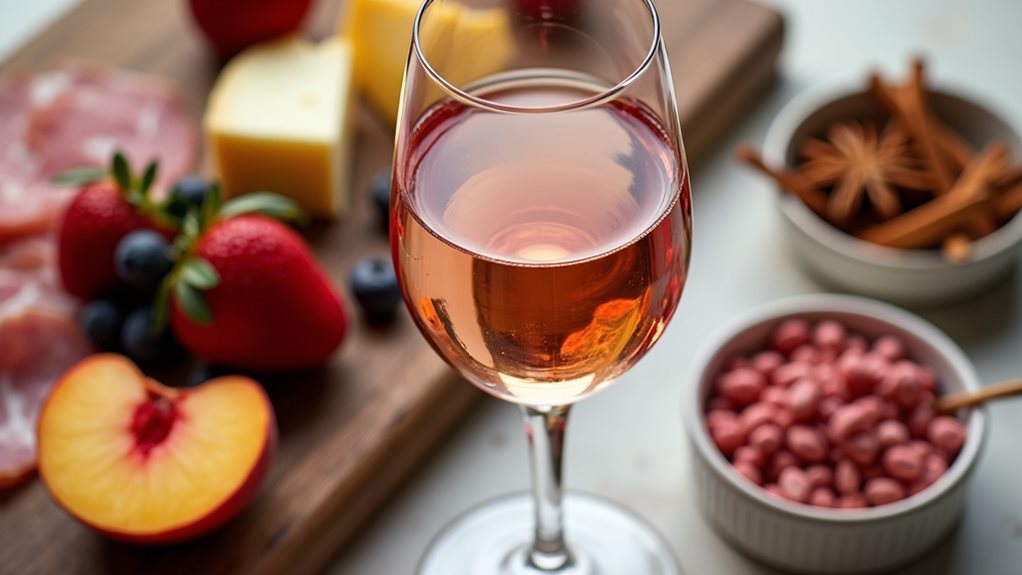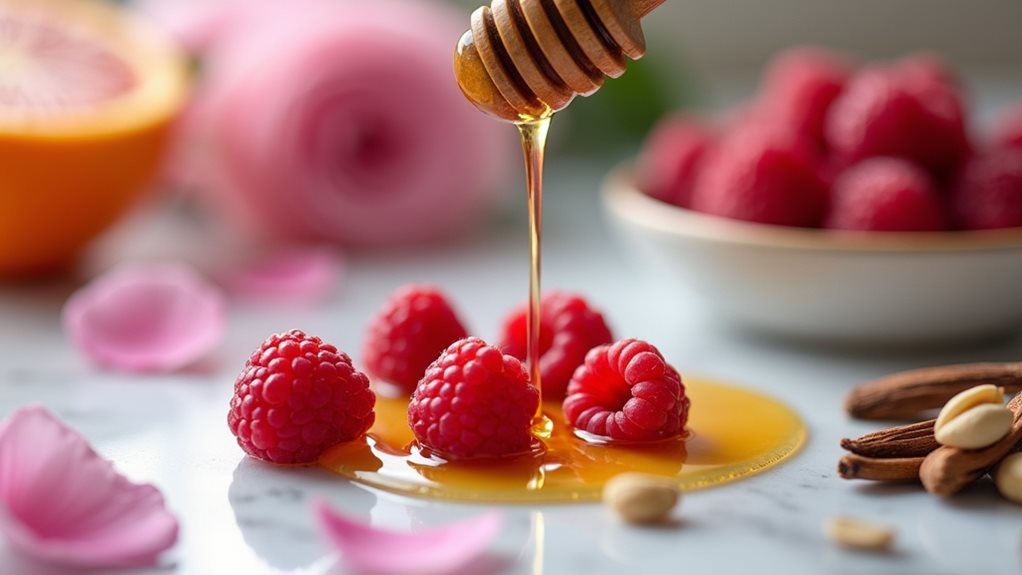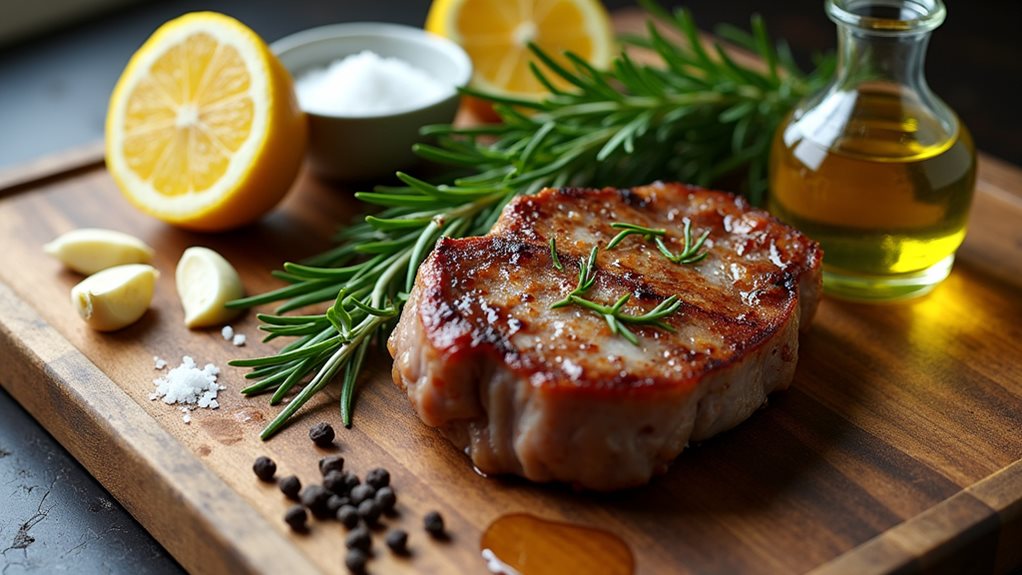Rosé wine pairs beautifully with herb-forward dishes like mint-infused platters and basil pesto that enhance its crisp berry notes. Serve it at 45-55°F to highlight its invigorating acidity alongside seafood with citrus marinades, Mediterranean vegetables, or spicy cuisine where it acts as a palate cleanser. For cheese pairings, try feta's briny tang with Provence rosé, while fuller-bodied Tavel rosés complement heartier fare like duck confit. The perfect pairing awaits in every glass.
Understanding the Unique Flavor Profile of Rosé Wine

When you're exploring the world of rosé wine, you'll quickly discover its remarkable versatility and distinctive character that sets it apart from both red and white varieties.
The beauty of rosé lies in its brilliant balance—offering the invigorating crispness of whites while retaining some of the depth and complexity of reds.
Rosé characteristics vary widely depending on production methods and regional influences. Experiencing a rosé properly involves both the first nose and second nose stages of analysis to fully appreciate its aromatic complexity.
You'll detect delicate notes ranging from strawberry and watermelon in Provençal styles to more robust cherry and raspberry flavors in Spanish rosados.
The flavor complexity develops through different production techniques: direct pressing creates lighter profiles, while longer maceration produces more intense tastes.
The ideal serving temperature of 45-55°F helps to highlight the wine's refreshing acidity and delicate flavors without dulling its aromatic qualities.
When evaluating a rosé, pay attention to both its primary aromas and the secondary notes that emerge after swirling—this layered experience reveals the wine's true personality.
Herb-Forward Dishes That Elevate Rosé's Character
When you're serving rosé with Mediterranean platters, try adding mint-infused components like herbed feta or fresh mint garnishes on grilled lamb to highlight the wine's crisp berry notes.
Your rosé's acidity will cut beautifully through basil pesto's richness, whether it's tossed with pasta, spread on crostini, or drizzled over roasted vegetables.
These herb-forward pairings work because they complement rather than compete with rosé's delicate flavor profile, creating a balanced tasting experience that brings out the best in both the wine and your carefully prepared dishes. The cooling, sweet aroma of mint specifically creates a refreshing contrast with the bright, berry-forward flavors of a dry rosé wine. The contrasting pairing approach works particularly well with herbs that have distinctive aromatic qualities, enhancing the overall dining experience. Consider bruising herbs like mint or basil before incorporating them into your dishes to release essential oils that will intensify their aromatic qualities alongside your rosé.
Mint-Infused Mediterranean Platters
Inspired by the aromatic traditions of Mediterranean cuisine, mint-infused platters offer a sublime canvas for showcasing rosé wine's delicate character.
You'll find that a revitalizing mint salad, scattered with dried rose garnish, creates visual harmony while complementing rosé's fruity notes. The cooling effect of mint balances rich ingredients like feta and olives, making each bite more vibrant. The refreshing taste profile of mint enhances the overall dining experience by providing a soothing sensation that pairs perfectly with rosé's crispness.
Try arranging colorful vegetable platters with herb-infused dips like tzatziki, where mint's brightness mirrors rosé's crispness. For an elegant touch, garnish your spreads with rose petals alongside fresh mint leaves. This versatile pairing exemplifies the fusion cuisine concept that has evolved through creative flavor experimentation over decades.
When serving grilled skewers, incorporate mint in your marinades to enhance compatibility with your chosen rosé. This marriage of herbal freshness and floral notes transforms ordinary gatherings into sophisticated dining experiences that honor Mediterranean cultural traditions. Consider brewing a rose-lavender-mint tea blend as a non-alcoholic alternative that offers calming properties similar to the relaxation provided by the wine pairing.
Basil Pesto Pairings
Basil pesto, with its vibrant green hue and aromatic intensity, creates a remarkable canvas for showcasing rosé wine's multifaceted character.
When experimenting with various basil varieties, from sweet Genovese to spicy Thai, you'll find rosé adapts beautifully to each nuance, particularly wines with subtle citrus undertones that complement the herb's freshness.
- Balance richness: Apply traditional pesto techniques like hand-grinding to release aromatic oils that pair perfectly with rosé's crisp acidity.
- Regional harmony: Combine Provençal rosés with traditional Ligurian pesto for a geographical pairing that honors the Mediterranean connection.
- Texture contrast: Match creamier pestos with more structured rosés to create satisfying mouthfeel.
- Ingredient consideration: Adjust your wine selection based on whether your pesto features stronger pine nuts or mellower walnuts. The bright, herbaceous qualities of traditional pesto create perfect synergy with dry rosés from Italian or French vineyards. Rosé's refreshing acidity makes it an excellent choice that cuts through the richness while enhancing the sauce's complex flavors.
For a unique twist, try incorporating roasted root vegetables into your pesto-based dishes, adding earthy depth that beautifully contrasts with rosé's fruit-forward profile.
Balancing Spice With Fruity Rosé Selections

Although many wine enthusiasts might overlook rosé when planning pairings for spicy cuisine, this versatile wine category offers remarkable complementary qualities that can transform your dining experience.
The natural acidity in rosé works as a palate cleanser between bites, while its fruit-forward profile creates a fruity balance that enhances similar notes in your dishes. The refreshing taste of rosé comes from shorter skin contact during production compared to red wines. Similar to mulled wine traditions, the enjoyment of rosé with spicy foods creates memorable shared experiences during gatherings.
When selecting the perfect bottle, consider the spice intensity. Opt for crisp, dry styles with Thai green curry or lightly spiced grilled shrimp, while medium-dry rosés complement Szechuan stir-fries.
For fiery Indian curries, reach for sweeter varieties that tame the heat. Medium dry rosés like White Zinfandel are particularly versatile with spicy dishes. Serve your selection properly chilled to maximize its invigorating qualities.
New World rosés from Merlot or Syrah grapes particularly excel with spicier foods, offering the perfect counterpoint to intense flavors.
Classic Mediterranean Pairings for Provence Rosé
Provence rosé's bright acidity and delicate mineral notes create a perfect backdrop for Mediterranean seafood, where citrus-driven dishes like grilled lemon shrimp or sea bass amplify the wine's invigorating qualities.
You'll find herbal vegetable creations, such as ratatouille or roasted zucchini with fresh thyme, complement the wine's subtle fruit profile while enhancing its natural herbaceous undertones.
Crumbled feta cheese atop a simple Greek salad or spread on crostini with olive tapenade offers a creamy, salty counterpoint that brings out the nuanced complexity hidden within a quality Provençal rosé.
The contrast between the wine's coolness and the warm spices found in dishes like Samosa Chaat creates a refreshing palate experience similar to how yogurt balances heat in traditional Indian street food.
Seafood And Citrus
The delicate minerality and bright acidity of Provence rosé create perfect harmony with seafood and citrus combinations that define Mediterranean cuisine.
When crafting seafood recipes, you'll find that the wine's invigorating profile softens the iodine character while preserving the delicate flavors of crab, oysters, and grilled fish.
Citrus marinades featuring lemon, lime, or orange don't just enhance your seafood—they mirror and amplify the fruity notes already present in your glass.
The wine's balanced acidity complements the brightness of citrus while cutting through the richness of dishes like salmon or tuna.
Just as mint and peas create a refreshing flavor profile in traditional European cuisine, rosé wines offer similar aromatic freshness to Mediterranean seafood dishes.
- Pair spider crab with Côtes-de-Provence for an elevated dining experience
- Add lemon zest to grilled sea bass for complementary brightness
- Try orange segments in seafood salads for unexpected harmony
- Experiment with lime-marinated shrimp tacos for a contemporary twist
Herbal Vegetable Dishes
When paired with herbal vegetable dishes, Provence rosé reveals its most authentic Mediterranean character. The wine's crisp acidity and subtle mineral notes create perfect harmony with grilled vegetable skewers seasoned with rosemary and thyme.
You'll find that herbal infusions of basil and garlic particularly enhance rosé's aromatic qualities.
For your summer gatherings, prepare Mediterranean-inspired vegetable roasts featuring zucchini, eggplant, and bell peppers. These earthy flavors, especially when drizzled with olive oil and fresh herbs, complement the strawberry and watermelon notes in your rosé.
Try serving a zucchini and goat cheese tart alongside a chilled glass—the creaminess balances the wine's dry finish beautifully. Ratatouille, a Provençal classic, also makes for an excellent pairing that showcases rosé's versatility with richly herbed vegetable combinations.
For an authentic experience, serve the ratatouille after a 15-20 minute rest, which allows the flavors to meld beautifully while enhancing both the dish and your rosé pairing.
Feta Cheese Delights
Feta's briny tanginess creates three perfect Mediterranean marriages with Provence rosé, each highlighting the wine's delicate fruit notes while balancing the cheese's distinctive saltiness.
You'll find this pairing especially invigorating during warmer months when both the cheese and wine shine brightest.
Various feta cheese variations offer different taste experiences with rosé:
- Young, creamy feta – Pairs beautifully with lighter, more acidic rosés that cut through its mild feta taste profile.
- Aged, crumbly feta – Demands a fruitier rosé with greater body to match its intensified flavor.
- Herb-infused feta – Complements the floral notes in Provence wines made from Grenache and Cinsault grapes.
- Barrel-aged feta – Creates complexity when paired with rosés featuring subtle oak influences.
Try serving feta stuffed peppers with a chilled glass of Provence rosé for an innovative appetizer experience.
For a complete Mediterranean-inspired meal, consider adding a herbed quinoa salad with roasted vegetables to complement both the cheese and wine while introducing nutritious whole grains to your pairing menu.
Hearty Food Matches for Fuller-Bodied Tavel Rosé
Unlike lighter rosés that partner with delicate dishes, fuller-bodied Tavel rosé demands heartier fare to showcase its robust character. This structured wine, with its medium tannins and luscious body, stands up beautifully to duck confit and slow-cooked lamb shoulder—hearty meat options that complement rather than overwhelm.
You'll find Tavel's fruit-forward profile of strawberry and pomegranate cuts through the richness of spicy lamb pie or grilled tacos. Its tannic edge and medium acidity make it surprisingly versatile with robust dishes like Thai green curry or habanero tacos. For a truly indulgent pairing, serve with braised short ribs that have been slow-cooked for 2.5-3 hours until tender and succulent.
For Mediterranean-inspired meals, pair it with hearty fish soup or seafood pasta with tomato sauce. Don't overlook vegetarian options—jackfruit tacos and spicy ratatouille create exceptional matches that highlight Tavel's depth and structure.
Cheese Board Essentials for the Perfect Rosé Tasting

Assembling the perfect cheese board for rosé requires thoughtful selection rather than random assortment of ingredients.
Consider the tasting notes of your rosé when choosing cheese varieties—pair lighter, crisp rosés with Brie or soft goat cheese, while reserving aged Gouda for deeper-hued selections.
For a truly memorable experience, include these strategic elements:
- Contrast of textures – Combine creamy Manchego with crunchy nuts and crisp rose-infused crackers.
- Complementary fruit pairings – Fresh strawberries highlight fruity notes in your rosé.
- Savory depth additions – Incorporate prosciutto and artichoke hearts alongside white cheddar.
- Innovative spreads – Feature chipotle rosé strawberry jam for an unexpected flavor dimension.
Don't forget whole-grain mustard and balsamic glaze to round out your board's flavor profile.
For a gourmet touch, include candied nuts which provide a perfect sweet-savory balance that has been complementing cheese and fruit combinations for centuries.
Vegetable Dishes That Complement Rosé's Acidity
Rosé's natural acidity creates a perfect canvas for vegetable dishes, cutting through richness while enhancing subtle flavors that might otherwise go unnoticed. When planning your vegetable pairings, consider how rosé acidity interacts with different cooking techniques and seasonings.
Grilled vegetables like yellow squash, zucchini, and bell peppers develop smoky notes that harmonize beautifully with dry rosés. For earthier options, try pairing turnips or roasted root vegetables with fruity rosés that balance their deep flavors.
Herbs play an important role too—tomato-basil salads and thyme-roasted carrots highlight the herbaceous undertones in many rosés. Don't shy away from spice; the fruity character in rosé can temper heat while complementing garlic-roasted cauliflower or chili-flaked dishes.
Regional specificity matters—Provence rosés excel with Mediterranean vegetables, while Spanish Rosados beautifully enhance artichokes.
Seasonal Fruit Pairings to Enhance Rosé Enjoyment
Fruits provide the perfect companion to rosé wine throughout the year, with each season offering unique flavor profiles that can elevate your wine experience.
Seasonal fruit pairings create remarkable flavor enhancement opportunities that you shouldn't miss. The natural acidity and sweetness in fruits complement rosé's characteristics beautifully.
- Spring treats – Pair your rosé with strawberries, raspberries, and clementines to highlight the wine's bright acidity.
- Summer refreshment – Watermelon, peaches, and mangoes match perfectly with drier rosés for poolside sipping.
- Autumn sophistication – Try pomegranates and pears to balance rosé's sweetness with subtle tartness.
- Winter warmth – Blood oranges and mandarin segments provide vibrant contrast against rosé's fruity notes.
Sweet Endings: Dessert Options for Dry and Sparkling Rosé
When the final course arrives at the table, selecting the perfect dessert to complement your rosé wine can transform an ordinary meal into a memorable experience.
For dry rosés, lighter options showcase the wine's delicate profile—try zabaglione custard, fruit tarts with fresh berries, or a classic lemon tart that balances acidity beautifully.
Sparkling rosé dessert pairings offer more decadent possibilities. Indulge in chocolate lava cake, whose rich center contrasts with the wine's effervescence, or experiment with rosé sorbet mimosas for an innovative twist.
When creating your own combinations, remember to balance sweetness levels and highlight complementary fruit notes.
Our rosé recommendations include matching berry-forward wines with chocolate-dipped strawberries or trying almond cake with a crisp, dry vintage.
Frequently Asked Questions
Can Rosé Be Paired With Asian or Fusion Cuisine?
You'll find various rosé varieties complement Asian and fusion cuisine beautifully. Their versatile flavor profiles balance spicy dishes like Thai curry and Korean BBQ while enhancing herbs and spices in innovative culinary combinations.
How Does Serving Temperature Affect Rosé's Pairing Compatibility?
You thought wine was just grape juice with attitude? Surprise! Serving temperature dramatically transforms your rosé's characteristics—warmer brings out richness for heartier foods, while cooler temperatures enhance crispness that complements lighter, delicate dishes. It's temperature alchemy!
Which Rosés Work Best With Smoky Barbecue Flavors?
For smoky barbecue, you'll want powerful rosés that can stand up to bold flavors. Choose Grenache, Syrah or Cinsault-based wines from Bordeaux, Côtes du Rhône or Pays d'Oc for an ideal pairing experience.
Are There Non-Alcoholic Alternatives With Similar Pairing Profiles?
Try non-alcoholic wines that mirror rosé's fruity profile or sparkling juices with berry notes. You'll find they're equally fantastic with smoky barbecue, complementing those rich flavors without the alcohol content.
How Do Vintage Variations Impact Rosé Food Pairing Recommendations?
Vintage characteristics markedly shape your rosé pairings. You'll notice older vintages develop complex tasting notes that complement richer dishes, while younger vintages with bright fruitiness work beautifully with lighter, seasonal fare.
Final Thoughts
Like Shakespeare's Cleopatra, the endless variety of rosé offers "infinite variety" in your culinary adventures. You'll find that experimenting beyond traditional pairings yields remarkable discoveries, whether you're serving a light Provence with herb-crusted fish or a robust Tavel alongside grilled lamb. Trust your palate's response to these suggestions, but don't hesitate to chart your own course. The beauty of rosé lies in its versatility—embrace it with confidence at your next gathering.















